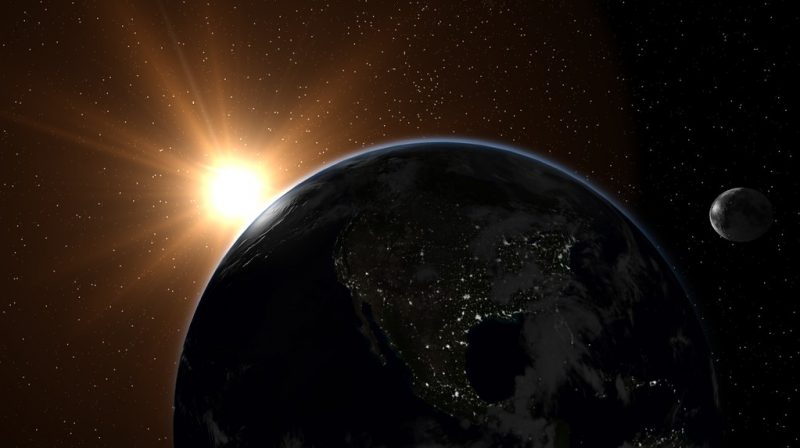
View the image above larger. | Kevin Gill on Flickr, who composed it, calls it High Speed Dirt.
Did you know that Earth’s seasons are slightly different lengths? By season, we mean the time between a solstice and an equinox. The upcoming season – between the December solstice and March equinox – is a touch shy of 89 days. It’s Earth’s shortest season.
The 2020 December solstice will happen on December 21. It’s when the sun will reach its southernmost point in our sky for this year. This solstice marks the beginning of the winter season in the Northern Hemisphere, and the start of the summer season in the Southern Hemisphere.
And, no matter where you are on Earth, it marks the beginning of your shortest season.
Contrast the number of days of the upcoming season with that of Earth’s longest season – the time between the June solstice and September equinox – in other words, a Northern Hemisphere summer or Southern Hemisphere winter. Earth’s longest season lasts 93.65 days.
Why? Why is the upcoming season nearly five days shorter?
The reason is that, every year in early January, the Earth swings closest to the sun for the year. This nearest point is called Earth’s perihelion. Because Earth reaches perihelion in late December and early January, our planet moves most swiftly in its orbit around now. That’s just physics: planets closer to the sun move faster. And it’s why a Northern Hemisphere winter, or Southern Hemisphere summer, is the shortest of the four seasons. It simply takes us fewer days at this time of year to move between a solstice and an equinox.
On the other hand, in early July, Earth is farthest from the sun and moving most slowly in its orbit. That’s why the longest season occurs at that time.
Here are the lengths of the astronomical seasons:
December solstice to March equinox: 88.99 days
March equinox to June solstice: 92.76 days
June solstice to September equinox: 93.65 days
September equinox to December solstice: 89.84 days
According to the computational wizard Jean Meeus, a Northern Hemisphere winter or Southern Hemisphere summer became the shortest season after the year 1246. The astronomical season between the December solstice and the March equinox will reach a minimum value of 88.71 days around the year 3500, and will continue to reign as the shortest season until about the year 6430.

Image via Kevin Gill on Flickr.
Bottom line: Earth’s shortest season begins at the solstice on December 21, 2020. The coming season – Northern Hemisphere winter or Southern Hemisphere spring – is a touch shy of 89 days in length.
Read more: All you need to know about 2020’s December solstice
EarthSky lunar calendars are cool! They make great gifts. Order now. Going fast!
Donate: Your support means the world to us
from EarthSky https://ift.tt/2CnGMPv

View the image above larger. | Kevin Gill on Flickr, who composed it, calls it High Speed Dirt.
Did you know that Earth’s seasons are slightly different lengths? By season, we mean the time between a solstice and an equinox. The upcoming season – between the December solstice and March equinox – is a touch shy of 89 days. It’s Earth’s shortest season.
The 2020 December solstice will happen on December 21. It’s when the sun will reach its southernmost point in our sky for this year. This solstice marks the beginning of the winter season in the Northern Hemisphere, and the start of the summer season in the Southern Hemisphere.
And, no matter where you are on Earth, it marks the beginning of your shortest season.
Contrast the number of days of the upcoming season with that of Earth’s longest season – the time between the June solstice and September equinox – in other words, a Northern Hemisphere summer or Southern Hemisphere winter. Earth’s longest season lasts 93.65 days.
Why? Why is the upcoming season nearly five days shorter?
The reason is that, every year in early January, the Earth swings closest to the sun for the year. This nearest point is called Earth’s perihelion. Because Earth reaches perihelion in late December and early January, our planet moves most swiftly in its orbit around now. That’s just physics: planets closer to the sun move faster. And it’s why a Northern Hemisphere winter, or Southern Hemisphere summer, is the shortest of the four seasons. It simply takes us fewer days at this time of year to move between a solstice and an equinox.
On the other hand, in early July, Earth is farthest from the sun and moving most slowly in its orbit. That’s why the longest season occurs at that time.
Here are the lengths of the astronomical seasons:
December solstice to March equinox: 88.99 days
March equinox to June solstice: 92.76 days
June solstice to September equinox: 93.65 days
September equinox to December solstice: 89.84 days
According to the computational wizard Jean Meeus, a Northern Hemisphere winter or Southern Hemisphere summer became the shortest season after the year 1246. The astronomical season between the December solstice and the March equinox will reach a minimum value of 88.71 days around the year 3500, and will continue to reign as the shortest season until about the year 6430.

Image via Kevin Gill on Flickr.
Bottom line: Earth’s shortest season begins at the solstice on December 21, 2020. The coming season – Northern Hemisphere winter or Southern Hemisphere spring – is a touch shy of 89 days in length.
Read more: All you need to know about 2020’s December solstice
EarthSky lunar calendars are cool! They make great gifts. Order now. Going fast!
Donate: Your support means the world to us
from EarthSky https://ift.tt/2CnGMPv

Aucun commentaire:
Enregistrer un commentaire